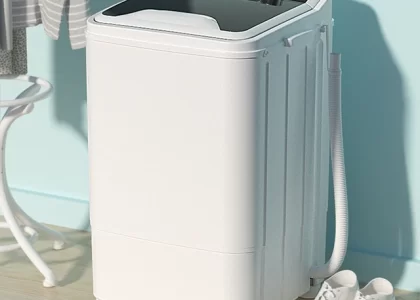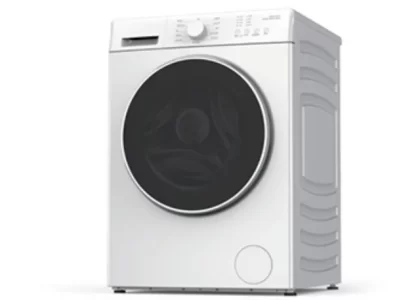 Introduction:
Introduction:
A smelly washing machine can be an unpleasant and frustrating problem to deal with. Over time, dirt, detergent residue, and moisture can accumulate in your machine, leading to unpleasant odors in your laundry. In this comprehensive guide, we will explore various methods and tips for effectively cleaning a smelly washing machine. By following these steps, you can eliminate odors and ensure that your washing machine operates at its best, keeping your clothes fresh and clean.
 Here are the common materials used in the construction of washing machines:
Here are the common materials used in the construction of washing machines:
Stainless Steel:
Stainless steel is a popular choice for the drum or tub of washing machines. It is resistant to rust and corrosion, making it suitable for prolonged exposure to water and detergent. Stainless steel drums provide durability and can withstand high-speed spins without warping.
Enamel-Coated Steel:
The outer body of washing machines is often made from enamel-coated steel. This material provides strength and protection while offering a smooth and visually appealing finish. The enamel coating helps prevent rust and contributes to the overall longevity of the machine.
Plastic:
Various components of washing machines, such as the control panels, detergent dispenser, and smaller parts, are typically made from plastic. Plastic is lightweight, cost-effective, and resistant to water and chemicals. It also helps reduce the overall weight of the machine.
Glass:
Some washing machines feature a transparent glass or plastic window on the door, allowing users to monitor the washing process. The glass used in these windows is specially tempered to withstand the high temperatures and vibrations produced during the washing cycle.
Rubber:
Rubber is commonly used for gaskets, seals, and hoses in washing machines. These rubber components help create watertight seals, prevent leaks, and absorb vibrations during operation. They are often made from durable and flexible materials that can withstand the constant movement and exposure to water.
Electronic Components:
Washing machines also contain various electronic components, such as circuit boards, sensors, and wiring. These components are usually housed in protective casings made from materials like plastic or metal to ensure their safety and longevity.
The specific materials used in a washing machine can vary depending on the manufacturer, model, and type of machine. Manufacturers carefully select materials that provide the necessary strength, durability, and resistance to water, chemicals, and mechanical stresses to ensure the overall performance and longevity of the appliance.
 Several popular types of washing machines:
Several popular types of washing machines:
There are several popular types of washing machines in the current market. Here are some of them:
Top-Load Washing Machines:
Top-load washing machines have a vertical drum where clothes are loaded from the top. They are known for their affordability, ease of use, and shorter wash cycles. However, they generally use more water and energy compared to front-load washers.
Front-Load Washing Machines:
Front-load washing machines have a horizontal drum where clothes are loaded through a door located at the front. They are known for their energy efficiency, water-saving features, larger capacity, and superior cleaning performance. Front-load washers are often more expensive than top-load washers.
High-Efficiency (HE) Washing Machines:
High-efficiency washing machines are designed to save both water and energy. They can be either top-load or front-load machines. HE washers use less water and detergent than traditional washers, while still providing effective cleaning results. They often have specialized washing cycles and features for optimal performance.
Washer-Dryer Combo:
Washer-dryer combo machines combine both washing and drying functions in a single unit. They are popular for compact spaces or situations where separate washing and drying units are not feasible. Washer-dryer combos are available in both top-load and front-load configurations.
Compact Washing Machines:
Compact washing machines are smaller-sized units that are perfect for apartments, condos, or small laundry rooms. They offer a space-saving solution while still providing the basic functionalities of a standard washing machine. Compact washers can be either top-load or front-load models.
Portable Washing Machines:
Portable washing machines are designed for portability and convenience. They are smaller, lightweight, and often require manual filling and draining of water. Portable washers offer a convenient laundry solution for RVs, camping trips, or small living spaces with limited access to laundry facilities.
These are some of the popular types of washing machines available in the current market. Each type has its own features, advantages, and considerations, and it’s important to choose one that best suits your needs, available space, and budget.
 Identifying the Source of the Odor
Identifying the Source of the Odor
Detergent and Fabric Softener Residue:
Excess detergent or fabric softener can cling to the interior of the machine, leading to unpleasant smells.
This residue can create a breeding ground for mold and bacteria, resulting in foul odors.
Moisture and Humidity:
Moisture and humidity can accumulate in parts of the machine, such as the drum, rubber gasket, or detergent drawer.
These damp conditions foster the growth of mold and mildew, creating musty smells.
Irregular Cleaning Routine:
Neglecting regular cleaning and maintenance of the washing machine can contribute to the development of odors.
Over time, the accumulation of dirt and grime makes it difficult for the machine to effectively clean clothes, leading to persistent odors.
Cleaning the Drum and Interior
Empty Drum Cleaning:
Run an empty cycle with hot water and 1-2 cups of white vinegar to help break down residues and eliminate odors.
For stubborn odors, add baking soda to the drum before running the cycle.
Rubber Gasket Cleaning:
Wipe down the rubber gasket with a mixture of equal parts vinegar and water to remove mold and mildew.
Pay attention to hidden areas, such as the folds of the gasket, where residue and mold can accumulate.
Detergent Drawer Cleaning:
Remove the detergent drawer and soak it in warm, soapy water.
Use a soft brush or toothbrush to scrub away any residue or buildup before rinsing and drying it thoroughly.
Maintaining a Odor-Free Washing Machine
How to clean a smelly washing machine?
Regular Cleaning Routine:
Establish a regular cleaning routine for your washing machine to prevent odors from recurring.
Depending on usage, clean the machine every 1-3 months to keep it fresh and odor-free.
Load Size and Detergent Usage:
Avoid overloading the machine to ensure that clothes have sufficient space to move freely and get properly cleaned.
Follow the manufacturer’s recommendations for detergent usage to prevent excessive buildup.
Leaving the Door Open:
After each cycle, leave the door of the washing machine open to allow air circulation and prevent moisture buildup.
This simple step can go a long way in preventing unpleasant odors.
Additional Tips and Tricks
Deodorizing with Baking Soda:
Sprinkle baking soda into the drum and run a hot water cycle to eliminate any remaining odors.
This natural deodorizer will neutralize the smell and leave your machine smelling fresh.
Cleaning the Filter:
Check your machine’s manual for instructions on locating and cleaning the filter.
Regularly removing and cleaning the filter prevents debris and buildup from contributing to odors.
Using Smell-Reducing Products:
Consider using commercial washing machine cleaning products or odor-absorbing tablets designed to keep your machine smelling fresh and clean.
Follow the instructions provided by the product manufacturer for best results.
 Conclusion:
Conclusion:
How to clean a smelly washing machine? A smelly washing machine can be resolved by identifying the source of the odor and following a proper cleaning routine. By regularly cleaning the drum, rubber gasket, and detergent drawer, you can eliminate residue, mold, and bacteria buildup resulting in foul odors. Additionally, maintaining a regular cleaning routine, following proper detergent usage, and allowing the machine to air dry after use will help prevent odors from returning. By following these tips and tricks, you can ensure that your washing machine remains clean, fresh, and odor-free, allowing you to enjoy clean and pleasantly scented laundry.




